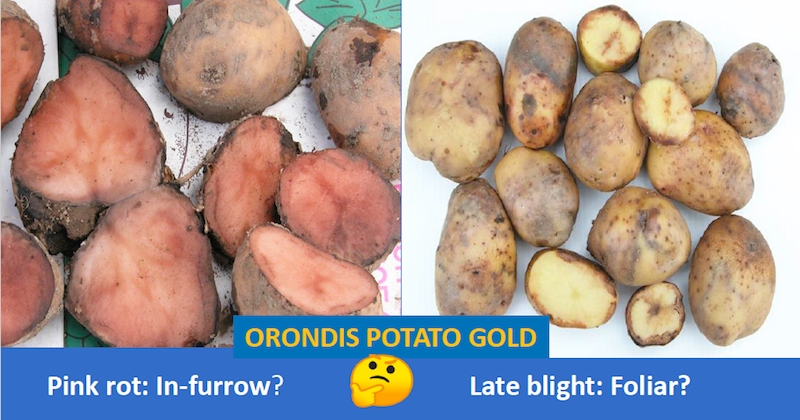
Features
Crop Watch
Chemicals
Deciding the application timing of Orondis
Orondis Potato Gold has been registered as an in-furrow treatment at planting for pink rot and Pythium leak or as a foliar application to control late blight. It’s one or the other, not both. So, what’s the best choice?
February 21, 2019 By Potatoes in Canada

In 2017, which was a wet year, potato growers who used Orondis Potato Gold for late blight were pleased with the fungicide’s performance, according to Ontario potato specialist Eugenia Banks. This year, potato growers can continue using the fungicide for late blight during the season, as long as it hasn’t been applied in-furrow at planting for pink rot control. This is a resistance management strategy to keep single-site fungicides like Orondis effective for an extended period of time, according to Banks.
There are several factors that should be considered when deciding the application timing of Orondis. Banks shares her top five tips that growers should keep in mind when making a decision on application timing.
- Most potato varieties are susceptible to either pink rot or leak, but research has shown that some varieties are particularly susceptible to pink rot. These varieties include Russet Norkotah, Dark Red Norland (often used as a susceptible standard), and the red skinned variety NorDonna. If you will grow any of these three varieties in 2019, then Orondis in-furrow is a good choice.
- The variety Yukon Gem has some resistance to late blight but not to pink rot. It is a good candidate for Orondis in-furrow.
- Varieties that usually develop lush foliage are good candidates for foliar applications of Orondis to reduce the incidence of late blight.
- The fumigant chloropicrin acts more like a fungicide than a biocide. It has been reported that chloropicrin controls pink rot and Pythium leak. Anecdotal evidence from Alliston, Ont. concurs with published reports: a fresh market grower used to have problems with Pythium leak every year. Since he started fumigating his Superiors with chloropicrin, he has not had problems with leak.
- If a field has had a history of pink rot, then there is no doubt that Orondis should be applied in-furrow.
“Potato growers know their fields and varieties very well; common sense allows them to make the right decisions. Thus, the final decision will be up to them,” Banks says.
Banks also consulted researchers to see if an Orondis fungicide application in the middle of May will still be active in September, when pink rot is most likely to develop.
Print this page